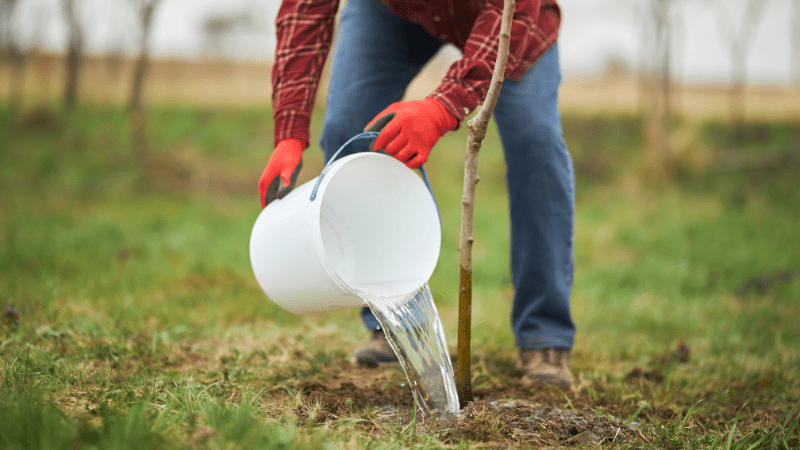Fall Watering Tips – How Much Moisture Do Your Trees Really Need?

Fall Watering Tips: How Much Moisture Do Your Trees Really Need Before Freeze-Up?
As Certified Arborists operating across Western Canada, we see it every year: homeowners putting away the hose too early. While the bright colours of autumn signal the end of the growing season, for your trees, the work isn’t quite over. Providing adequate moisture in the late fall is one of the most critical steps you can take to ensure your trees survive a cold Prairie winter and emerge healthy next spring.
Below, we break down our arborist-backed approach to pre-winter watering.
Why the Deep Soak is a Critical Pre-Winter Strategy
The transition to winter dormancy is a resource-intensive process for any tree. As temperatures drop and the growing season ends, your tree’s root system begins to store energy and shut down its physiological processes.
Our Expert Take:
Deep, late-season watering is essentially filling your tree’s reserves. This stored moisture is crucial for two reasons:
- Fuelling Dormancy: The tree needs moisture to sustain its cells throughout the winter, even when dormant.
- Preventing Root Desiccation: During long, cold spells, especially with windy conditions, moisture can be slowly pulled from the soil and from the roots themselves. If the ground freezes without sufficient water reserves, the roots can dry out—a condition known as desiccation—leading to severe stress or even death, particularly during an early or dry spring thaw.
We recommend a slow, deep watering that penetrates the top 12-18 inches of the soil. This encourages the development of strong, deep roots and ensures the entire root zone is saturated before the freeze.
Focus Your Efforts: Newer Plantings and Evergreens
While all trees benefit from a final soak, your watering efforts should be disproportionately focused on two key groups in your landscape:
Newer Plantings (Trees Planted in the Last 3 Years)
Young trees have underdeveloped, shallow root systems that are less efficient at drawing up and storing moisture than established trees. They are the most vulnerable to desiccation. Continue to treat these younger trees with special care until the soil is consistently frozen.
Evergreens (Pines, Spruces, Firs, Cedars, etc.)
Unlike deciduous trees, evergreens never truly “shut down” completely. They retain their needles throughout the winter, which means they are constantly losing a small amount of moisture through a process called transpiration.

When the ground is frozen, their roots cannot pull up new water, but their needles continue to transpire in the cold, windy air. If their reserves are low before the freeze, they are prone to winter burn or browning come spring. A deep soak for your evergreens in the fall is their most reliable defence against winter damage.
The Arborist’s Rule: Know When to Stop
The goal is to water the tree, not turn the soil into a muddy mess after the frost has set in. Knowing when to stop is just as important as knowing when to start.
Stop watering once the following conditions are met:
- The ground is frozen solid: Once the soil is frozen to a depth that prevents water absorption, any additional moisture will simply run off or freeze on the surface, potentially damaging the roots.
- Daytime highs consistently stay below zero (0° C): When temperatures stay below freezing for several days in a row, the ground is unlikely to thaw sufficiently to absorb water, signalling that the tree has entered its hard dormancy.
In most areas across our service regions, this cut-off typically occurs in late October or early to mid-November, depending on the season’s onset.
Get a Certified Assessment
Proper fall care is vital for the long-term health and vigour of your trees. If you’re unsure about your specific watering needs, or if you’ve noticed signs of stress or poor health, our ISA-Certified Arborists can provide a science-backed assessment of your trees and shrubs. We’re here to help your trees thrive—not just survive—the harsh winter season.
FAQs
Are your arborists local to each service area?
What are the costs of regular tree health care?
What areas does Green Drop provide emergency tree services?
What does your DED management program involve?
What services do you offer?
Explore Our Latest Insights


5 Signs Your Tree Is in Trouble (And What to Do About It)
